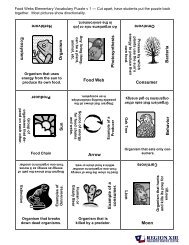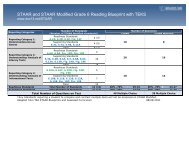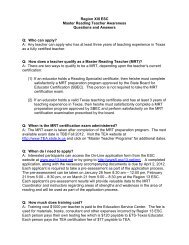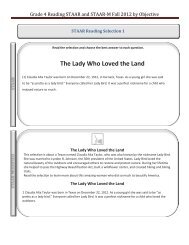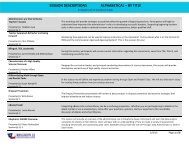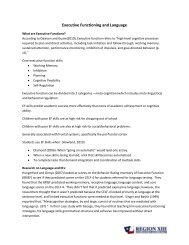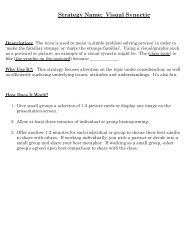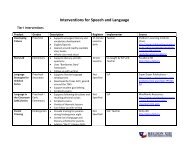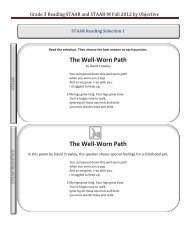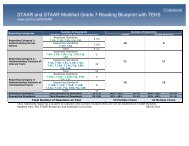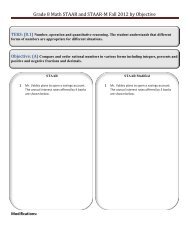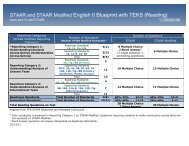2010—2011 Second <strong>Six</strong> <strong>Weeks</strong> PreviewSocial Studies8 th GradeUnit 3: The War for Independence. The unit focus is on the American Revolution. History content focuses on the political,economic, and social issues and events of the revolutionary era. The War for Independence originally started as aresponse to taxation. However, this issue of freedom had been manifesting since America’s inception. The taxation fromthe French and Indian War was just the catalyst needed to bring about the inevitable. For the British, the American Revolutionwas about colonists having the duty to pay for services like all British citizens would be obligated to do. However,for the Americans it was about the freedom to choose the kind of life they wanted for themselves.Unit 4: A New Nation. This unit focuses on the creation and ratification of the United States Constitution. Students examineAmerican beliefs and principles, including limited government, checks and balances, federalism, separation ofpowers and individual rights reflected in the U. S. Constitution.World GeographyUnit 3: United States & Canada. The unit is a study of the United States and Canada in the region of North America.This unit will compare the different physical and cultural regions of the region, focusing on settlement patterns, movementof people, human-environment interaction, and relationships among the neighboring countries.Unit 4: Latin America. In this unit students will explore Latin America through the conceptual lens of regional development.Students will learn how various physical landscapes and climates promote or inhibit settlement and growth. Studentswill study demographic, economic, and political data, as well as current events, in order to understand the way inwhich Latin American cultures and governments have changed over time.World HistoryUnit 3: Middle Ages. This unit, combined with Unit 4 covers the important people, issues and events of a lengthy timeperiod called the Middle Ages. The focus of the unit is on why and how institutions were developed and maintained. Institutionsaddressed include the legal system (Jury) and Parliament in England, the organizational structure behind feudalism,the Roman Catholic church, and higher education.Unit 4: Islam and the Crusades. This unit is connected to the previous unit bringing closure to the Middle Ages. Onefocus of the unit is the Crusades which sparked changes and conflict in the Western world that lead to the next great era,the Renaissance. The unit will also introduce the world of Islam that exerts influence in the Middle East and the world tothis day.U. S. HistoryUnit 3: The Progressive Era. This unit focuses on the effects of the “Gilded Age”. The Progressive Era was filled withpockets of grass-roots coalitions that mounted reform movements on the local, state and national fronts by lobbying forpolicies that would correct political, economic and social inequities. By allowing individuals to initiate and petition forthese reforms, it expanded the democratic process for many, but it also increased the people’s dependence on the federalgovernment to solve problems. This expansion of the government’s responsibilities along with their ability to makelong-term systemic changes enabled them to extend their power during another national crisis- The Great Depression.Unit 4: The United States in World Affairs. The unit focuses on the events and issues that ushered the United Statesonto the world stage. America’s success in the Spanish-America War changed its interactions with the world. This unitinvestigates the context of the times, America’s internal struggle between practicality and its values and beliefs, as wellas The Great War itself, with a special focus on the Treaty of Versailles, which set up the conditions for World War II.26
2010—2011 Second <strong>Six</strong> <strong>Weeks</strong> PreviewSocial StudiesGovernmentUnit 3: The Legislative Branch: Congress. With the “background” of U.S. government filled in, students now begin acloser study of the three branches of government. The Legislative Branch, “The People’s Branch,” is discussed in ArticleOne of the Constitution, which outlines the many powers delegated to Congress, including the power to make laws, coinmoney, tax, declare war, and impeach judges and the president. In this unit students investigate questions such as,“How does the legislature work? What are the functions of Congress? What powers does it have and how are thosepowers limited? What impact have legislative decisions had on America?”Unit 4: The Executive Branch: The Presidency & The Bureaucracy. Article II of the Constitution describes the role ofa new kind of leader. The Founders wanted a strong leader, but one with limited power and a set term of office. Sincethe 1780’s, the role of president has changed significantly, and today the President of the United States is considered bymany to be the most powerful person in the world. This unit investigates the executive branch, headed by the president,and the eight distinct roles the president and executive branch of the government play: chief of state, chief executive,chief administrator, chief diplomat, commander in chief, chief legislator, chief of party, and chief citizen.EconomicsUnit 3: Macroeconomics: Government Policy. A market economy is prone to alternating periods of growth and contraction,and thinkers throughout modern history have offered different visions of the role of the government in regulatingor moderating the effects of the free enterprise system. Today, our government actively monitors the performance of thenational economy through measures such as gross domestic product (GDP), inflation, and unemployment, and uses fiscalpolicy to try to achieve the goals of growth and stability. Over the last century and a half, organizations such as laborunions have sought to protect workers participating in a market economy, while successful entrepreneurs have oftenbeen those people who found new ways for the market system to better meet the demands of producers or consumers.Unit 4: Macroeconomics: Money and Banking. All economic operations depend on the flow of money and creditthrough the economy. Unit 4 examines the functions of the financial system and how they have evolved over time, thefoundations of borrowing, lending, and investment decisions by households and institutional lenders, and how the FederalReserve controls the volume of this lending to achieve macroeconomic goals.This unit focuses on Money and Banking - how individual consumers acquire goods and services, how the individualsdecide to participate in the financial system through investments, and then how monetary policy (actions of the Fed) canaffect the amount of consumer interaction in the economy (domestic and global).27



